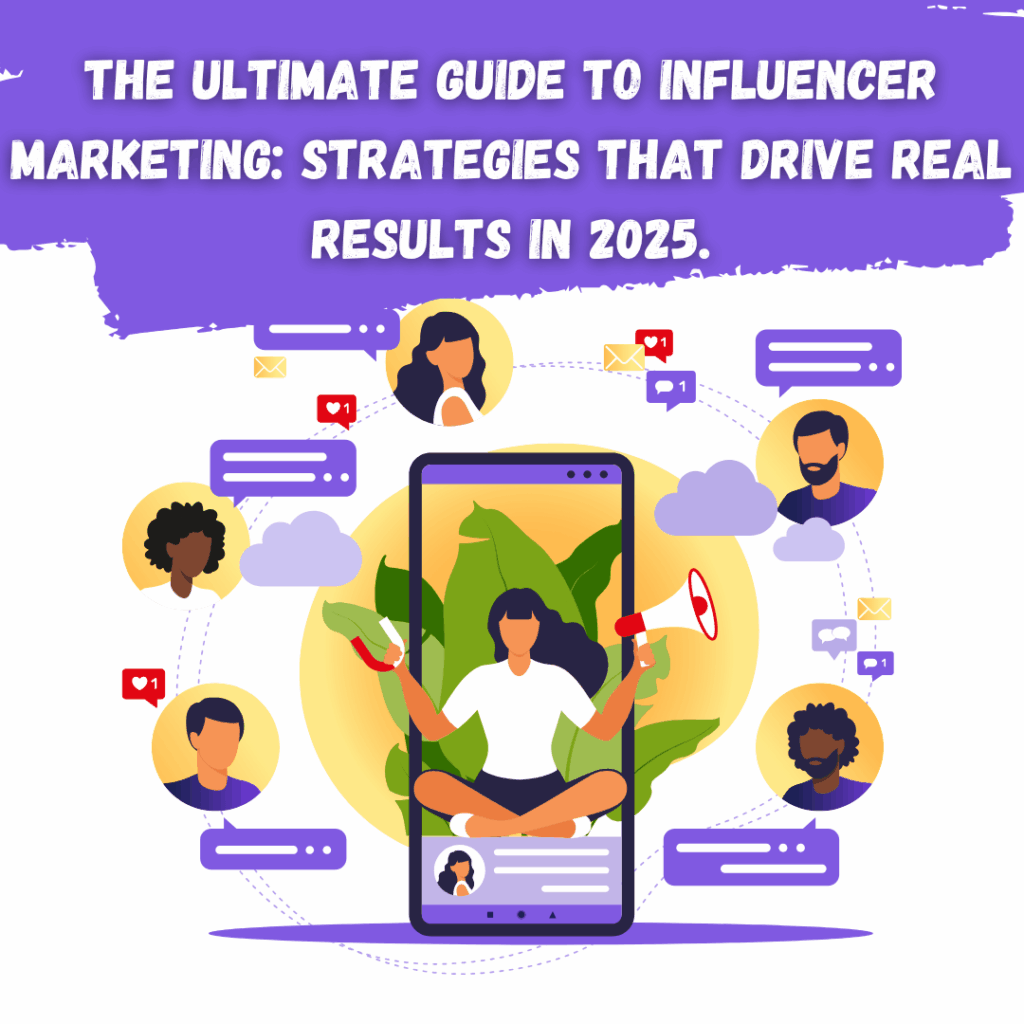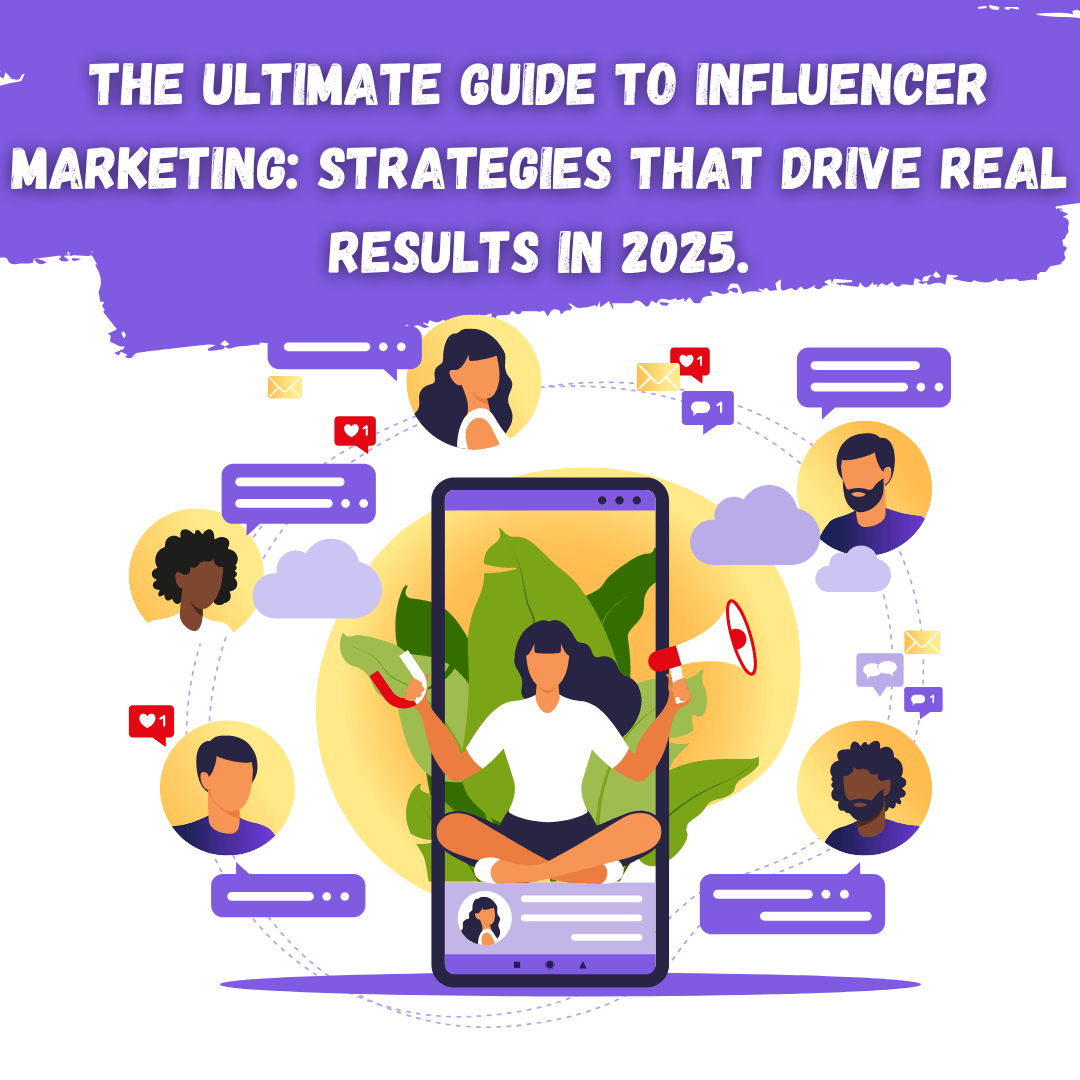Table of Contents
Introduction

Did you know that businesses earn an average of $5.20 for every dollar spent on influencer marketing? This remarkable return on investment has transformed influencer marketing from a trendy experiment into an essential component of modern digital marketing strategies.
In today’s hyper-connected world, consumers trust recommendations from people they follow online almost as much as they trust their friends. This shift in consumer behavior has created unprecedented opportunities for brands to connect with their target audiences through authentic, engaging content created by influencers.
This comprehensive guide will walk you through everything you need to know about influencer marketing in 2025. You’ll discover how to develop winning strategies, find the perfect influencers for your brand, measure your success, and avoid costly mistakes that can derail your campaigns. Whether you’re a small business owner taking your first steps into influencer marketing or a seasoned marketer looking to refine your approach, this guide provides actionable insights to help you succeed.
What Is Influencer Marketing? Understanding the Fundamentals
Influencer marketing is a strategic collaboration between brands and individuals who have built dedicated followings on social media platforms. These influencers create content featuring your products or services, sharing it with their engaged audiences in an authentic, relatable way.
The landscape of influencer marketing has evolved dramatically since its early days. What started with celebrity endorsements has transformed into a diverse ecosystem of content creators across every niche imaginable. Today’s influencer marketing encompasses:
Mega-influencers (1M+ followers) bring massive reach but often at premium prices and potentially lower engagement rates. Think celebrities and internet personalities with household name recognition.
Macro-influencers (100K-1M followers) offer substantial reach with more targeted audiences. These creators have often built their followings around specific interests or expertise.
Micro-influencers (10K-100K followers) deliver highly engaged communities and authentic connections. Research shows they often achieve engagement rates 60% higher than mega-influencers.
Nano-influencers (1K-10K followers) provide hyper-local or niche targeting with the highest engagement rates, perfect for small businesses or specialized products.
The primary platforms driving influencer marketing today include Instagram, TikTok, YouTube, and LinkedIn, with emerging platforms like BeReal and Threads gaining traction. Each platform offers unique advantages: Instagram excels at lifestyle and visual content, TikTok dominates short-form entertainment, YouTube leads in long-form educational content, and LinkedIn captures B2B audiences.
Benefits of Influencer Marketing for Modern Brands
Increased Brand Awareness and Reach
Influencer marketing opens doors to audiences you might never reach through traditional advertising. When an influencer shares your brand with their followers, you’re not just getting exposure – you’re getting introduced by a trusted voice. This warm introduction can dramatically accelerate brand awareness and expand your reach into new demographics.
The authentic nature of influencer content helps it cut through the noise of traditional advertising. While consumers have become adept at ignoring banner ads and skipping commercials, they actively seek out content from their favorite influencers. This eager consumption means your brand message gets delivered in a context where audiences are receptive and engaged.
Cost-effectiveness sets influencer marketing apart from many traditional channels. While a national TV campaign might cost millions, partnering with micro-influencers can deliver targeted reach for a fraction of the price. Small businesses can start with nano-influencers for just hundreds of dollars, making influencer marketing accessible to brands of all sizes.
Building Trust and Credibility
Trust forms the foundation of successful influencer marketing. When an influencer recommends your product, their endorsement carries the weight of social proof. Studies show that 61% of consumers trust influencer recommendations, compared to just 38% who trust branded social media content.
This trust translates into credibility for your brand. Influencers spend years building relationships with their audiences, and when they partner with your brand, you benefit from that established trust. The key lies in authentic partnerships where influencers genuinely believe in your products and can share honest experiences with their followers.
Long-term partnerships amplify these trust benefits. When audiences see an influencer consistently using and recommending your products over time, it reinforces authenticity and builds stronger brand affinity than one-off sponsored posts ever could.
Measurable ROI and Performance
Unlike traditional advertising’s often fuzzy metrics, influencer marketing delivers measurable results. Modern tracking tools and platform analytics provide clear visibility into campaign performance, from reach and engagement to direct sales conversions.
Brands typically see engagement rates between 1-5% for influencer content, significantly higher than the 0.05-0.1% average for traditional digital ads. These engaged audiences translate into tangible business results, with studies showing influencer marketing drives 11 times higher ROI than traditional digital marketing.
Attribution has become increasingly sophisticated, with unique promo codes, trackable links, and pixel tracking enabling precise measurement of each influencer’s contribution to your bottom line. This data-driven approach allows continuous optimization of your influencer marketing strategy.
How to Develop an Influencer Marketing Strategy
Setting Clear Goals and KPIs
Success in influencer marketing starts with crystal-clear objectives. Are you looking to increase brand awareness among Gen Z consumers? Drive sales for a new product launch? Build a community around your brand values? Each goal requires different strategies, influencer types, and success metrics.
Your key performance indicators (KPIs) should align directly with these goals. Brand awareness campaigns might focus on reach, impressions, and share of voice. Sales-driven campaigns track conversion rates, revenue, and customer acquisition costs. Engagement-focused initiatives measure comments, shares, and user-generated content creation.
Set specific, measurable targets for each KPI. Instead of “increase brand awareness,” aim for “reach 500,000 unique users in our target demographic within 60 days.” This specificity enables accurate performance tracking and ROI calculation.
Identifying Your Target Audience
Deep audience understanding forms the cornerstone of effective influencer marketing. Start by analyzing your existing customer data to identify demographic patterns, interests, and online behaviors. Tools like Google Analytics, social media insights, and customer surveys provide valuable data points.
Create detailed buyer personas that go beyond basic demographics. What are their pain points? Which social platforms do they prefer? What type of content resonates with them? Understanding these nuances helps you select influencers whose audiences align with your ideal customers.
Platform preferences matter significantly. Gen Z dominates TikTok, millennials engage heavily on Instagram, professionals network on LinkedIn, and YouTube attracts diverse age groups seeking educational content. Match your platform strategy to where your audience spends their time.
Finding the Right Influencers for Your Brand
The search for perfect brand partners requires systematic evaluation beyond follower counts. Start with influencer discovery platforms like AspireIQ, GRIN, or Upfluence, which offer sophisticated search filters and audience analytics.
Evaluate potential partners across multiple criteria. Engagement rate (likes + comments / followers) should typically exceed 2% for Instagram, 5% for TikTok. Analyze audience authenticity using tools like HypeAuditor to identify fake followers. Review content quality, brand safety, and alignment with your values.
The vetting process should include reviewing past partnerships, checking for controversies, and assessing professionalism in communications. Request media kits and case studies from previous campaigns. Look for influencers who maintain long-term brand relationships, indicating reliability and professionalism.
Types of Influencer Marketing Campaigns
Sponsored Content and Product Placements
Sponsored content remains the backbone of influencer marketing, but success requires seamless integration with the influencer’s natural content style. The best sponsored posts feel authentic rather than advertising, maintaining the influencer’s voice while highlighting your brand’s value propositions.
FTC guidelines mandate clear disclosure of paid partnerships. Influencers must use platform-specific disclosure tools and explicit language like #ad or #sponsored. These requirements protect consumers and maintain trust in influencer recommendations.
Creative briefs balance brand requirements with influencer creativity. Provide key messages, brand guidelines, and campaign objectives while allowing influencers flexibility in execution. Their expertise in engaging their specific audience often produces better results than overly prescriptive directions.
Brand Ambassadorships and Long-term Partnerships
Ambassador programs create deeper connections between influencers and brands. These ongoing relationships typically span 6-12 months or longer, featuring regular content creation, event appearances, and authentic brand integration into the influencer’s lifestyle.
Long-term partnerships deliver superior ROI through authentic storytelling and audience trust building. Followers see genuine product use over time, making recommendations more credible. Ambassadors become true brand advocates, often promoting products organically beyond contracted obligations.
Structure these partnerships with clear expectations, exclusive benefits, and performance incentives. Many brands offer tiered ambassador programs, rewarding top performers with increased compensation, exclusive products, or co-creation opportunities.
Affiliate Marketing and Promo Codes
Performance-based influencer campaigns align incentives perfectly. Influencers earn commissions on sales they generate, motivating authentic promotion and careful audience targeting. This model works particularly well for e-commerce brands with strong conversion funnels.
Unique promo codes serve dual purposes: providing follower value through discounts while enabling precise tracking of each influencer’s impact. Codes should be memorable, often incorporating the influencer’s name or handle for easy recall and brand association.
Commission structures typically range from 5-20% of sales, with higher rates for exclusive partnerships or high-value products. Some brands combine flat fees with performance bonuses, ensuring influencer compensation while incentivizing results.
User-Generated Content Campaigns
UGC campaigns transform customers into brand advocates, amplifying reach through authentic peer recommendations. Successful campaigns create compelling reasons for participation: contests, challenges, or causes that resonate with your audience’s values and interests.
Hashtag campaigns provide simple participation mechanisms while enabling easy content discovery and measurement. Create unique, memorable hashtags that communicate campaign themes while avoiding potential negative associations or existing uses.
Repurposing rights maximize UGC value. Secure permissions to use participant content across your marketing channels, from social media to website galleries and advertising campaigns. This authentic content often outperforms professional photography in driving conversions.
Measuring Influencer Marketing Success
Key Metrics to Track
Comprehensive measurement encompasses both quantitative metrics and qualitative insights. Reach and impressions indicate campaign visibility, while engagement rates reveal audience interest and content quality. Track likes, comments, shares, and saves to understand content resonance.
Click-through rates and website traffic from influencer content measure audience intent. Use UTM parameters and dedicated landing pages to attribute traffic accurately. Monitor time on site and pages per session to assess visitor quality.
Conversion tracking reveals bottom-line impact. Whether measuring sales, sign-ups, or app downloads, establish clear attribution windows and tracking mechanisms. Consider both immediate conversions and longer-term customer lifetime value from influencer-acquired customers.
Tools and Platforms for Analytics
Native platform analytics provide foundational data. Instagram Insights, TikTok Analytics, and YouTube Studio offer detailed performance metrics for business accounts. These free tools deliver sufficient data for basic campaign measurement.
Third-party platforms enhance measurement capabilities. Tools like Hootsuite, Sprout Social, and Later aggregate cross-platform data, enabling holistic campaign views. Specialized influencer marketing platforms like CreatorIQ and Klear provide advanced analytics including competitor benchmarking and audience quality scores.
Google Analytics remains essential for website impact measurement. Set up custom campaigns, track influencer traffic separately, and create goals aligned with your campaign objectives. Integration with e-commerce platforms enables complete purchase funnel visibility.
Calculating ROI
ROI calculation requires comprehensive cost accounting beyond influencer fees. Include product costs, shipping, agency fees, and internal time investment. Total investment provides accurate baselines for return calculations.
Direct revenue attribution uses promotional codes, affiliate links, and pixel tracking. Calculate gross revenue, subtract total costs, and divide by investment for ROI percentage. Remember that influencer marketing often delivers value beyond immediate sales through brand awareness and content creation.
Long-term value assessment considers customer lifetime value, brand sentiment improvements, and content asset creation. Influencer-created content often provides months of value through repurposing across marketing channels. Factor these extended benefits into ROI calculations for complete campaign evaluation.
Common Influencer Marketing Mistakes to Avoid
The allure of massive follower counts often leads brands astray. Mega-influencers might impress with millions of followers, but micro-influencers frequently deliver better ROI through higher engagement rates and more targeted audiences. Focus on relevance and engagement over raw reach.
Authenticity cannot be manufactured. Forcing influencers into scripts or overly controlling content creation produces stilted, ineffective campaigns. Trust influencers to communicate with their audiences authentically while ensuring brand safety through clear guidelines.
Vague contracts create problems. Specify deliverables, timelines, usage rights, and payment terms explicitly. Include morality clauses, exclusivity periods, and performance expectations. Clear agreements prevent misunderstandings and protect both parties.
Many brands launch campaigns without proper tracking infrastructure. Install pixels, create unique landing pages, and establish attribution systems before campaigns begin. Retroactive measurement rarely provides accurate insights.
FTC non-compliance risks significant penalties. Ensure all influencers understand disclosure requirements and monitor compliance throughout campaigns. Provide disclosure language examples and use platform partnership tools consistently.
Best Practices for Influencer Marketing Success
Building Authentic Relationships
Personalization transforms cold outreach into warm connections. Research influencers thoroughly before contact, referencing specific content you appreciated and explaining genuine brand alignment. Mass emails rarely succeed in attracting quality influencers.
Fair compensation respects influencer professionalism. While rates vary by follower count, engagement, and content requirements, paying fairly ensures quality work and positive relationships. Consider the time, creativity, and audience value influencers provide.
Relationship nurturing extends beyond active campaigns. Engage with influencer content regularly, share their posts, and maintain communication between campaigns. Strong relationships lead to better content and potential organic brand mentions.
Creating Effective Campaign Briefs
Clear briefs balance structure with creative freedom. Include campaign objectives, key messages, mandatory elements, and brand guidelines while avoiding micromanagement. Explain the ‘why’ behind requirements to help influencers create authentic content.
Visual examples clarify expectations better than lengthy descriptions. Provide mood boards, previous successful content, and brand asset libraries. Show what success looks like while encouraging influencer interpretation.
Timeline clarity prevents rushed content. Build buffer time for revisions and approvals. Respect influencer schedules and platform optimal posting times. Rush requests often result in subpar content and strained relationships.
Legal and Ethical Considerations
Disclosure compliance varies by country. US FTC, UK ASA, and other regulatory bodies maintain specific requirements. Stay updated on regulations in all markets where you operate. Provide influencers with region-specific guidance.
Intellectual property rights require careful negotiation. Specify usage rights duration, channels, and modification permissions. Many influencers grant limited licenses rather than full ownership. Respect these boundaries while securing necessary marketing rights.
Crisis management protocols protect brand reputation. Establish procedures for handling influencer controversies, including content removal triggers and public response strategies. Quick, decisive action minimizes potential damage.
The Future of Influencer Marketing: Trends to Watch
Artificial intelligence reshapes influencer marketing through virtual influencers and enhanced analytics. AI-powered influencers like Lil Miquela demonstrate new possibilities, while machine learning improves influencer discovery and performance prediction.
Video content dominance accelerates across platforms. Short-form video on TikTok and Reels, long-form content on YouTube, and live streaming everywhere require adapted strategies. Brands must support influencers with video-optimized creative briefs and assets.
Niche platforms emerge serving specific communities. Gaming platforms like Twitch, audio platforms like Clubhouse, and professional networks beyond LinkedIn create new influencer marketing opportunities. Early adoption often yields competitive advantages.
Performance-based partnerships become standard as measurement improves. Hybrid models combining base fees with performance bonuses align stakeholder interests. Expect increased focus on sales attribution and long-term value metrics.
Social commerce integration transforms influencer content into direct sales channels. Platform shopping features, livestream commerce, and seamless checkout experiences reduce friction between discovery and purchase. Optimize campaigns for these evolving commerce capabilities.
Conclusion
Influencer marketing has evolved from experimental tactic to essential strategy for brands seeking authentic connections with modern consumers. Success requires thoughtful strategy, careful influencer selection, and commitment to authentic partnerships that benefit brands, influencers, and audiences alike.
The key takeaways from this guide center on authenticity, measurement, and relationship building. Choose influencers based on audience alignment rather than follower counts. Establish clear goals and tracking mechanisms before launching campaigns. Invest in long-term relationships that create lasting brand value.
Your next steps depend on your current influencer marketing maturity. Beginners should start small with micro-influencer campaigns, testing and learning before scaling. Experienced marketers should audit existing programs against best practices, identifying optimization opportunities.
The influencer marketing landscape will continue evolving, but fundamental principles remain constant: authentic partnerships, valuable content, and mutual respect create campaigns that resonate with audiences and drive business results. Start implementing these strategies today to build meaningful connections with your target customers through the trusted voices they already follow and admire.
Additional Resources
To support your influencer marketing journey, we’ve compiled essential resources. Access influencer outreach templates, campaign brief examples, and contract frameworks in our resource library. These tools accelerate campaign development while ensuring professional execution.
Our curated directory lists top influencer marketing platforms, analytics tools, and service providers. Compare features, pricing, and user reviews to select solutions matching your needs and budget. Regular updates ensure current information.
Case studies from successful campaigns provide inspiration and practical insights. Learn from brands achieving exceptional results across industries and influencer tiers. Each case study includes strategies, metrics, and lessons learned.
The influencer marketing glossary defines industry terminology, platform-specific features, and measurement metrics. Reference this resource when encountering unfamiliar terms or explaining concepts to stakeholders. Clear communication enables better collaboration across teams and partners.

